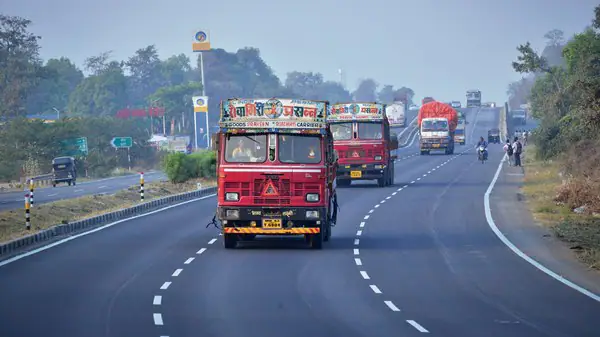Simply put, all that road transport is, in short, is the movement of people and products in cars, trucks, and buses. It moves things between locations and depends on a huge network of roadways, which includes streets, highways, and those little country routes, you know? And keep in mind that supply chains and logistics depend heavily on road transit. It enables the direct delivery of products to your door without any additional processing. Short and medium-distance road transportation is incredibly flexible and adaptable, accommodating all kinds of goods and travel requirements. So yes, road transportation is essential to achieving any goal, be it driving to the center of a busy metropolis or shipping a parcel to a very far-off village. In today’s day and age, we can’t simply live without road transport because the economy of a nation depends on it. And yes, it directly affects everyone in the country. Let’s read some advantages and disadvantages of Road Transport in India:

Advantages of Road Transport
1. Flexibility and Accessibility
Well, first of all, it really is very easy to change routes and plans for road transport based on what is needed at the time. Road transport can change based on traffic, road closures, or customer requests, unlike fixed train or air routes, you know? This adaptability is important for businesses that are always changing, especially those that do e-commerce, so they can make sure packages get to all of their places on time, no matter what.
2. Door-to-Door Service
Direct delivery is one of the best things about road transport, right? Have you experienced the same with the recent e-commerce boom? The goods are picked up at the source and sent straight to the destination, without having to go through more than one handle point, and that’s the best bit.
3. Cost-Effective
Rail transport may be cheap, but compared to shipping goods on a container ship or via air transport, road transport is super cheap. It really is when you look at the numbers. Though, it’s very cheap for short to medium lengths, which makes it perfect for small and medium-sized businesses. All in all, keeping prices low is easier when shipping costs are low.
4. Speed and Efficiency
Sure, over the long-distance shipping of goods or even traveling, air transport is the best way, but when it comes to shorter distances, road transport is the real king. How? Well, in contrast to air or train transport, it avoids delays and guarantees fast delivery of goods, which is very important for shipments that need to get there quickly.
5. Reaching Remote Areas
One of the main reasons why we have roads is to connect rural parts of the nation to more developed parts so that there can be a link and everyone can get to wherever they want.
6. Simplified Logistics and Lower Packaging Costs
Because there are fewer handling spots for road transport, less complicated packaging is needed. So what does that mean for you though? Well, that means lower packaging costs and a smoother process overall, what else do you want?
7. Reduced Risk of Damage
Goods are less likely to get damaged when they are handled less often, that’s kinda the equation when it comes to shipping things, right? And that is precisely where road transport is better than any other way of transporting goods.
Disadvantages of Road Transport
1. Weather Issues
The weather affects road transport. No doubt, it does. Floods, heavy rain, snow, and fog can all mess up plans and cause delays, and this isn’t particularly an issue with road transport, it is in the context of transport in general, you know? Still, this lack of predictability is a big problem for businesses that depend on supplies happening on time.
2. Accidents and Breakdowns
It is more like a fact that more accidents and problems happen on the roads than on any other type of transportation. And when these accidents occur, they can very well put human lives at risk, you know, the drivers that have taken the responsibility to transport some goods. Things like driver fatigue, bad car maintenance, and bad road conditions all raise the risk.
3. Heavy and Bulky Cargo
Simply put, it’s hard to move a lot of big stuff by road. It costs more and is harder to do because you need special vehicles and more planning, but on the other hand, with rail and container transport, it is pretty much feasible.
4. Speed Limitations
When we talk about long-distance transportation of goods, it is 100% true that road transport is slower than airplanes or trains. For packages that need to get there quickly, this slower speed is a problem because delays can affect the whole supply chain. So no doubt, when it comes to longer trips, the road isn’t as good as other modes of transportation.
5. Organizational Chaos
It is a hard truth that a lot of the time, the road logistics industry feels like it is broken up and not controlled as much as other transportation industries. Sure, this lack of uniformity hits hard, wastes time, and makes it overall harder to put best practices into action. It can really be even harder to get your goods moving, especially when you aren’t in contact with the right service provider who doesn’t know too much about how to transport things locally.
6. Fuel Price Rollercoaster
Lastly, changes in the price of fuel have a big effect on the costs of road transportation. And this is the only thing that can very well have an effect on how much the goods being transported will cost to the end consumer. The higher the fuel prices, the bigger the cost will be to transport things, and eventually, that cost will affect the end consumer or customer.
Comparison Between Advantages and Disadvantages of Road Transport
|
Advantages |
Disadvantages |
| Easy route and plan changes | Weather-dependent and prone to delays |
| Direct delivery from source to destination | Higher accident and breakdown risk |
| Cost-effective for short to medium distances | Difficulties with heavy and bulky cargo |
| Fast delivery for short distances | Slower for long-distance transportation |
| Access to remote areas | Fragmented and less regulated logistics |
| Simplified logistics and lower packaging costs | Vulnerable to fuel price fluctuations |
| Reduced risk of damage due to less handling |



